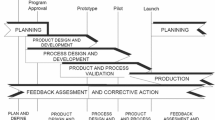Abstract
One of the most important research subjects germane to knowledge management in collaborative manufacturing is the integration of heterogeneous product knowledge distributed among different collaborative enterprises. To deal with the problem of optimization of knowledge integration in collaborative manufacturing, an ontology-based framework of knowledge integration is presented to transform the problem of knowledge integration into a problem of ontology integration. First of all, a collaborative business process for collaborative enterprises is described, and then an ontology-based framework of knowledge integration is established. Under the condition of analyzing the structure of knowledge ontology, an ontology schema of knowledge concept is discussed. Aiming at the ontology schema, a method of ontology integration based on ontology similarity is improved. The method is composed of ontology mapping and ontology merging, which is based on calculated result of ontology similarity between local ontology and global ontology. Finally, the implementation of the framework of knowledge integration is described, and the application results meet the requirement of the knowledge integration to ensure that validity of the ontology integration method was proved.
Similar content being viewed by others
Reference
Lin HK, Harding JA, Shahbaz M (2004) Manufacturing system engineering ontology for semantic interoperability across extended project teams. Int J Prod Res 42(24):5099–5118. doi:10.1080/00207540412331281999
Anderson C, Bunce P (2000) Next generation manufacturing systems (NGMS). White Paper, CAM-I, Burleson, Texas
Alisantoso D, Khoo LP, Lee IBH, Lu WF (2006) A design representation scheme for collaborative product development. Int J Adv Manuf Technol 30:30–39. doi:10.1007/s00170-005-0051-8
Lee JY, Kim K (2007) A distributed product development architecture for engineering collaborations across ubiquitous virtual enterprises. Int J Adv Manuf Technol 33:59–70. doi:10.1007/s00170-006-0443-4
Bombardier V, Mazaud C, Lhoste P, Vogrig R (2007) Contribution of fuzzy reasoning method to knowledge integration in a defect recognition system. Comput Ind 58:355–366. doi:10.1016/j.compind.2006.07.006
Bless PN, Klabjan D, Chang SY (2008) Heuristics for automated knowledge source integration and service composition. Comput Oper Res 35:1292–1314. doi:10.1016/j.cor.2006.08.012
Lin HK, Harding JA (2007) A manufacturing system engineering ontology model on the semantic web for inter-enterprise collaboration. Comput Ind 58:428–437. doi:10.1016/j.compind.2006.09.015
Zhang WY, Yin JW (2008) Exploring Semantic Web technologies for ontology-based modeling in collaborative engineering design. Int J Adv Manuf Technol 36:833–843. doi:10.1007/s00170-006-0896-5
Ye Y, Yang D, Jiang Z, Tong L (2008) Ontology-based semantic models for supply chain management. Int J Adv Manuf Technol 37:1250–1260. doi:10.1007/s00170-007-1052-6
Seog-Chan Oh, Yee S-T (2008) Manufacturing interoperability using a semantic mediation. Int J Adv Manuf Technol 39:199–210. doi:10.1007/s00170-007-1198-2
McGuinness DL, Fikes R, Hendler J, Stein LA (2002) DAML+OIL: an ontology language for the Semantic Web. IEEE Intell Syst 17(5):72–80. doi:10.1109/MIS.2002.1039835
Deborah L. McGuinness, Frank van Harmelen (2004) OWL Web Ontology Language Overview, http://www.w3.org/TR/2004/REC-owl-features-20040210/.
Mitra P, Wiederhold G, Kersten M (2000) A graph-oriented model for articulation of ontology interdependencies. Advances in Database Technology-EDBT 2000:86–100. doi:10.1007/3-540-46439-5_6
Baader F, Calvanese D, McGuinness DL, Nardi D, Pater-Schneider PF (2003) The description logic handbook: theory, implementation, and applications. Cambridge University Press, Cambridge, pp 76–78
Chein M, Mugnier M (2008) Graph-based knowledge representation computational foundations of conceptual graphs. Springer, London
Fellbaum C (1998) WordNet: an electronic lexical database. MIT Press, Cambridge
Kim KY, David GM, Yang H (2006) Ontology-based assembly design and information sharing for collaborative product development. Computer-Aided Design 38:1233–1250. doi:10.1016/j.cad.2006.08.004
Fortuna B, Mladenič D, Grobelnik M (2006) Semi-automatic construction of topic ontologies. Semantics, Web and Mining 4289:121–131. doi:10.1007/11908678_8
Lee C-S, Kao Y-F, Kuo Y-H, Wang M-H (2007) Automated ontology construction for unstructured text documents. Data Knowl Eng 60:547–566. doi:10.1016/j.datak.2006.04.001
Roche C (2000) Corporate ontologies and concurrent engineering. J Mater Process Technol 107:187–193. doi:10.1016/S0924-0136(00)00713-5
McClean S, Scotney B, Morrow P, Greer K (2008) Integrating semantically heterogeneous aggregate views of distributed databases. Distrib Parallel Databases 24:73–94. doi:10.1007/s10619-008-7031-6
Cruz IF, Xiao H (2009) Ontology driven data integration in heterogeneous networks. Complex systems in knowledge-based environments. Theory, Models and Applications 168:75–98. doi:10.1007/978-3-540-88075-2_4
Ding Y, Foo S (2002) Ontology research and development: part 2—a review of ontology mapping and evolving. J Inf Sci 5:375–388. doi:10.1177/016555150202800503
Dey L, Singh S, Rai R, Gupta S (2005) Ontology aided query expansion for retrieving relevant text. Proc Adv Web Intell 3528:126–132. doi:10.1007/11495772_21
Wei Sun, Qin-Yi Ma, Tian-Yi Gao, Shuang Chen (2009) Knowledge-intensive support for product design with an ontology-based approach. Int J Adv Manuf Technol, published online: September 2009. doi:10.1007/s00170-009-2268-4
Vallet D, Fernández M, Castells P (2005) An ontology-based information retrieval model. J. the semantic web: research and applications: and European semantic web conference (ESWC 2005). Lect Notes Comput Sci 3532:455–470. doi:10.1007/11431053_31
Kim W, Choi DW, Park S (2005) Product information meta-search framework for electronic commerce through ontology mapping. Proceedings of Semantic Web: Research and Applications 3532:408–422. doi:10.1007/11431053_28
Kim W, Choi DW, Park S (2008) Agent based intelligent search framework for product information using ontology mapping. J Intell Inf Syst 30(3):227–247. doi:10.1007/s10844-006-0026-8
Pan R, Ding Z, Yu Y, Peng Y (2005) A Bayesian network approach to ontology mapping. Proceedings of the Semantic Web-ISWC 2005 3729:563–577. doi:10.1007/11574620_41
TANG J, LI JZ, LIANG BY, Huang X, Li Y, Wang K (2006) Using Bayesian decision for ontology mapping. Web Semantics: Science, Services and Agents on the World Wide Web 4:243–262. doi:10.1016/j.websem.2006.06.001
Kim KM, Hong JH, Cho SB (2007) A semantic Bayesian network approach to retrieving information with intelligent conversational agents. Inf Process Manag 43:225–236. doi:10.1016/j.ipm.2006.04.001
Min Jung, Hong-Bae Jun, Kyun-Woo Kim, Hyo-Won Suh (2009) Int J Adv Manuf Technol, Publiched online August 2009. doi:10.1007/s00170-009-2268-4
Mizoguchi R, Tijerino Y, Ikeda M (1995) Task analysis interview based on task ontology. Expert Syst Appl 9:15–25. doi:10.1016/0957-4174(94)00044-V
Gruber TR (1993) A translation approach to portable ontologies. Knowl Acquis 5:199–220. doi:10.1006/knac.1993.1008
Saaty TL (1990) Multicriteria decision making: the analytic hierarchy process: planning, priority setting, resource allocation, 2nd edn. RWS, Philadelphia
Author information
Authors and Affiliations
Corresponding author
Rights and permissions
About this article
Cite this article
Jiang, Y., Peng, G. & Liu, W. Research on ontology-based integration of product knowledge for collaborative manufacturing. Int J Adv Manuf Technol 49, 1209–1221 (2010). https://doi.org/10.1007/s00170-009-2463-3
Received:
Accepted:
Published:
Issue Date:
DOI: https://doi.org/10.1007/s00170-009-2463-3




